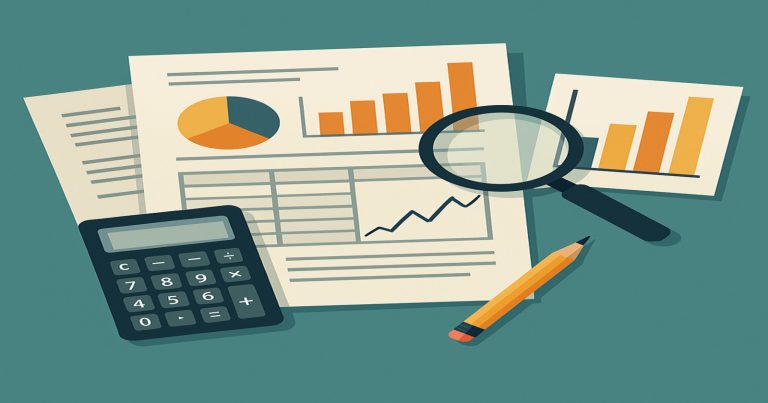Learning about business financing, like many things, can be a complex process. But there are ways to ease your burden. The first one is doing tools of financial statement analysis. These tools allow you to gauge how a business is performing. It helps to see if the company is financially killing it, losing its pants, and/or financially responsible.
Tools of financial statement analysis involves the methods or steps used to study financial data. They help investors, managers and others make educated decisions. They help you see the whole picture of how a company is performing.
By the end of this article, you’ll learn all of the tools and techniques of financial statement analysis. This guide is for everyone from a student, business owner, or an investor. Finally, by the end, you will learn the simple language of the tools used for analysis of financial statements. You’ll know about the top three tools of financial statement analysis tools used by people.
Definition of Financial Statement Analysis
Financial statement analysis means lifting up financial statements. These are income statements, balance sheets, and cash flow statements. People use them to estimate the way a firm acts with cash.
This helps address some questions like:
- Is the company in the black?
- Can it pay its debts?
- Is it growing?
- Is the expenditure under control?
These tools or techniques of financial statement analysis address such questions. Financial statement analysis can be done by anyone. It is used by business owners, accountants, investors — even students. This helps in making better financial decisions. It means checking figures, looking for trends, comparing ratios, and so on. These guide you to understand where the business is performing and where it needs attention.
Tools of financial statement analysis help to condense large numbers into simple insights. They provide clarity, and they guide better choices.
Types of Financial Statements
In order to understand the tools used for an analysis of a financial statement, you should know the statements that everybody analyses. There are three main types. These are for various segments of a business’s finances.
Income Statement (profit and loss statement)
This shows profit and loss. It reports how much a company made and spent during a period. It helps to view net profit, revenue, and expenses.
Balance Sheet
It is a statement of what the company owns and owes. It consists of assets, liabilities, and equity. When you can tell whether the company is strong or weak financially.
Cash Flow Statement
This is how money comes into and goes out of the business. It indicates whether the company has sufficient cash to conduct its daily operations.
All three are necessary to make a sound financial analysis. These declarations are mutually reinforcing. Some people also use:
- Statement of changes in equity
- Notes to accounts
The three above, however, are the foundation tools for financial statement analysis.
Tools of Analysis of Financial Statements
They help interpret the financial reports. They point to trends, strengths and risks, and to growth. You can employ these tools when you set up your own business or while contemplating a venture, with or without further investment. They shed light on complex numbers.
Comparative financial statements
Such statements present two or more years side by side. You can compare numbers such as sales, profits or assets through the years. It can help you determine whether the business is growing or shrinking.
So, if last year was ₹10 lakh revenue and this year ₹12 lakh, it is a growth of 20%. This is one of the patterns this tool displays.
Common-Size Statements
These represent each item as a percentage of a total. For example, if you are analyzing a common-size income statement, all items appear as a percentage of sales.
This facilitates the comparison of firms of various sizes. It also assists in comparing changes from year to year.
Trend Analysis
This tool examines changes over decades. You use it to just check whether sales, profits or costs are going up or down.
E.g. profit in year 1 ₹10k, in year 2 ₹15k, in year 3 ₹20k upward moving trend. It allows the forecasting of future outcomes.
It is one of the three standard tools of financial statement analysis employed in the context of business reports.
Ratio Analysis
This is one of the most popular and powerful tools. It assists in comparing various components of the financial statement. It illustrates ratios such as profit to sales or debt to equity.
There are various types of ratios that an investor or analyst can look at:
- Liquidity Ratios (e.g., Current Ratio)
- Profitability Ratios ( e.g., Net Profit Margin)
- Efficiency Ratios (i.e. Inventory Turnover)
Each tells a different story. Put together they make a full picture.
Cash Flow Analysis
This is based on the cash flow statement. It examines the sources and uses of cash. It lets you know whether the company can pay its bills or make investments to grow.
It is an essential tool for businesses with high volumes of cash transactions. It reveals whether profits are supported by actual cash.
Importance of Tools of Financial Statement Analysis
You avoid making mistakes by utilizing tools of financial statement analysis. It trains you to see what is really going on in the numbers.
You get to know:
- Is the company actually doing well?
- Is it borrowing too much?
- Is it stable or risky?
These tools are used by business owners for planning. They are widely used by investors before investing their money. Bankers consult them before extending loans. They help in:
- Taking better decisions
- Saving money
- Spotting risks early
- Tracking goals
So, never ignore these tools. They put some meaning to financial data.
Relevance to ACCA Syllabus
The tools of financial statement analysis topic falls under the Financial Reporting (FR) & Strategic Business Reporting (SBR). ACCA students are frequently required to Evaluate that performance and position of different business entities from the informative point of view of Financial Statements through applying ratio analysis, trend analysis and other analytical techniques.
Tools of Analysis of Financial Statements ACCA Questions
Q1: What do you call the ratio when each line item in a financial statement is compared to the value of a total line item in the same financial statement as a greater proportion?
A. Ratio Analysis
B. Common-Size Statement
C. Trend Analysis
D. Comparative Statement
Answer: B
Q2: Which Ratio Would Tell You About Long-Term Leverage?
A. Return on Equity
B. Debt to Equity Ratio
C. Current Ratio
D. Gross Profit Margin
Answer: C
Q3: What type of analysis tool gives you a trend of the important values over this time period?
A. Trend Analysis
B. Liquidity Analysis
C. Cash Flow Forecasting
D. Common-Size Statement
Answer: A
Q4 Which of the following is NOT a tool for financial statement analysis?
A. Variance Analysis
B. Ratio Analysis
C. Common-Size Analysis
D. Comparative Statements
Answer: A
Q5: Base: common-size balance sheet as in
A. Total Revenue
B. Net Assets
C. Total Liabilities
D. Total Assets
Answer: D
Relevance to US CMA Syllabus
It comes under the head of “Financial Reporting, Planning, Performance and Control” in the US CMA exam. Candidates required ratio analysis, trend, and interpret financial statements by internal decision making.
Tools of Financial Statement Analysis US CMA Questions
Q1: What tool does the the comparing financial performance across companies of different sizes use?
A. Ratio Analysis
B. Variance Analysis
C. Common-Size Statement
D. Cash Flow Statement
Answer: C
Q2 : from the following which is a profitability ratio?
A. Debt-Equity Ratio
B. Quick Ratio
C. Return on Assets (ROA)
D. Inventory Turnover
Answer: C
Q3: In what has the trend analysis been most helpful in making:
A. Single-year performance
B. Asset valuation
C. Long-run growth or decline
D. Common-size comparison
Answer: C
Q4: What is the financial ratio that indicates how fast inventory is sold or restocked?
A. Debt Ratio
B. Inventory Turnover
C. Return on Capital
D. Gross Profit Margin
Answer: B
Q5 Internal control method the study of financial statements?
A. Trend Analysis
B. Ratio Analysis
C. Budgeting
D. Common-Size Analysis
Answer: B
Relevance to CFA Syllabus
The Financial Reporting and Analysis (FRA) module in the CFA curriculum covers tools for analysis of finances. Providing tools to study valuation, risk and performance, candidates are required to analyze financial statements.
Tools of Financial Statement Analysis CFA Questions
Q1: Financial Statements are studied over a period by which analytical tools?
A. Benchmarking
B. Ratio Analysis
C. Trend Analysis
D. Liquidity Analysis
Answer: C
Q2: In a common-size income statement, each line item is represented as a proportion of:
A. Total Equity
B. Net Profit
C. Total Sales
D. Operating Income
Answer: C
Q3: Which of the following ratios is not considered a measure of solvency?
A. Net Profit Margin
B. Quick Ratio
C. Debt to Equity Ratio
D. Current Ratio
Answer: C
Q4: What does high inventory turnover ratio tell us?
A. Low sales performance
B. Poor stock management
C). Mixed Goods Volume or Inventory Turnover
D. High liquidity risk
Answer: C
Q5: What does the asset turnover ratio represent? Meaning of this ratio in sales of a business?
A. Return on Equity
B. Asset Turnover Ratio
C. Interest Coverage Ratio
D. Liquidity Ratio
Answer: B
Relevance to US CPA Syllabus
Keep in mind that financial statement analysis appears on the FAR (Financial Accounting and Reporting) and BEC (Business Environment and Concepts) sections of the CPA exam. CPA candidates use assessment tools to analyze business financial health, identify relevant information, and analyze operations.
Tools of Financial Statement Analysis US CPA Questions
Q1 : Which of the following is not a drawback of the ratio analysis?
A. Comparable results
B. The industry benchmarks are not integrated
C. Uses standardized formulas
D. Has its own depth of understanding
Answer: B
Q2: What is the reason behind attaching the more conservative label to the quick ratio compared to the current ratio is:
A. Cash
B. Prepaid expenses
C. Inventory
D. Receivables
Answer: C
Q3: Which analysis could help spot seasonal patterns of your financial performance?
A. Comparative Statements
B. Ratio Analysis
C. Trend Analysis
D. Vertical Analysis
Answer: C
Q4: Company vs. peers — comparison — what would help most?
A. Trend Analysis
B. Common-Size Statements
C. Variance Analysis
D. Forecasted Income
Answer: B
Q5: How is it best to measure a company’s ability to pay interest?
A. Return on Assets
B. Interest Coverage Ratio
C. Debt to Equity Ratio
D. Gross Margin Ratio
Answer: B


